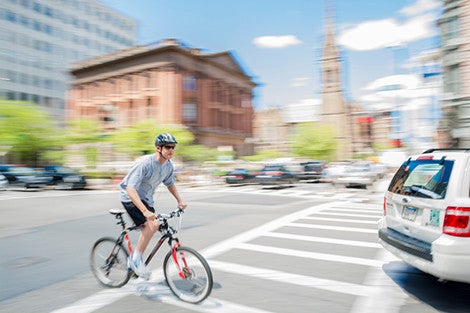June 27, 2014 — Boston has installed more than 50 miles of bike lanes since 2007, and the number of pedal-powered commuters in the city, while only 2.1%, is more than three times the national average. To help urban planners continue to improve bike friendliness, researchers at Harvard School of Public Health (HSPH) set out to determine the types of lanes that expose cyclists to the smallest amount of vehicle pollution.
The researchers attached a mobile monitoring unit to the back of a bicycle and hit the road to sample two types of pollutants from vehicular exhaust—black carbon and nitrogen dioxide—known to increase the risk of asthma, heart disorders, and other health problems. They traveled five common bicycling routes in the city during both morning and evening commutes, to compare bike paths, which are separated from the road, and bike lanes, which run adjacent to traffic.
Bike paths had the best air quality, with concentrations of both pollutants about a third lower than on bike lanes. This was true even when bike paths near crowded streets were compared with bike lanes on quieter streets, suggesting that separation from the road and a protective barrier of vegetation, such as trees and bushes, makes a difference. Bike paths also allow cyclists to bypass intersections, where idling cars make the air quality particularly bad.
Piers MacNaughton, SM ’14, led the data analysis, which was published online May 16, 2014 in Science of the Total Environment. He earned his degree in the Exposure, Epidemiology and Risk Program in the Department of Environmental Health and will start a PhD in the program this fall.
A bike commuter himself, MacNaughton said the aim of the study is not to scare off city bicyclists but rather to provide evidence to shape future urban planning—particularly now that Boston is on the short list of host cities for the 2024 Olympics. “They are really pushing to be a biking capital. I wanted to get this research out so that when they start developing more bike lanes, they can do so in a smart way,” MacNaughton said.
Read abstract: Impact of bicycle route type on exposure to traffic-related air pollution
Read Boston Globe coverage: Cyclists, don your gas masks
Photo: iStockphoto/Christopher Badzioch
